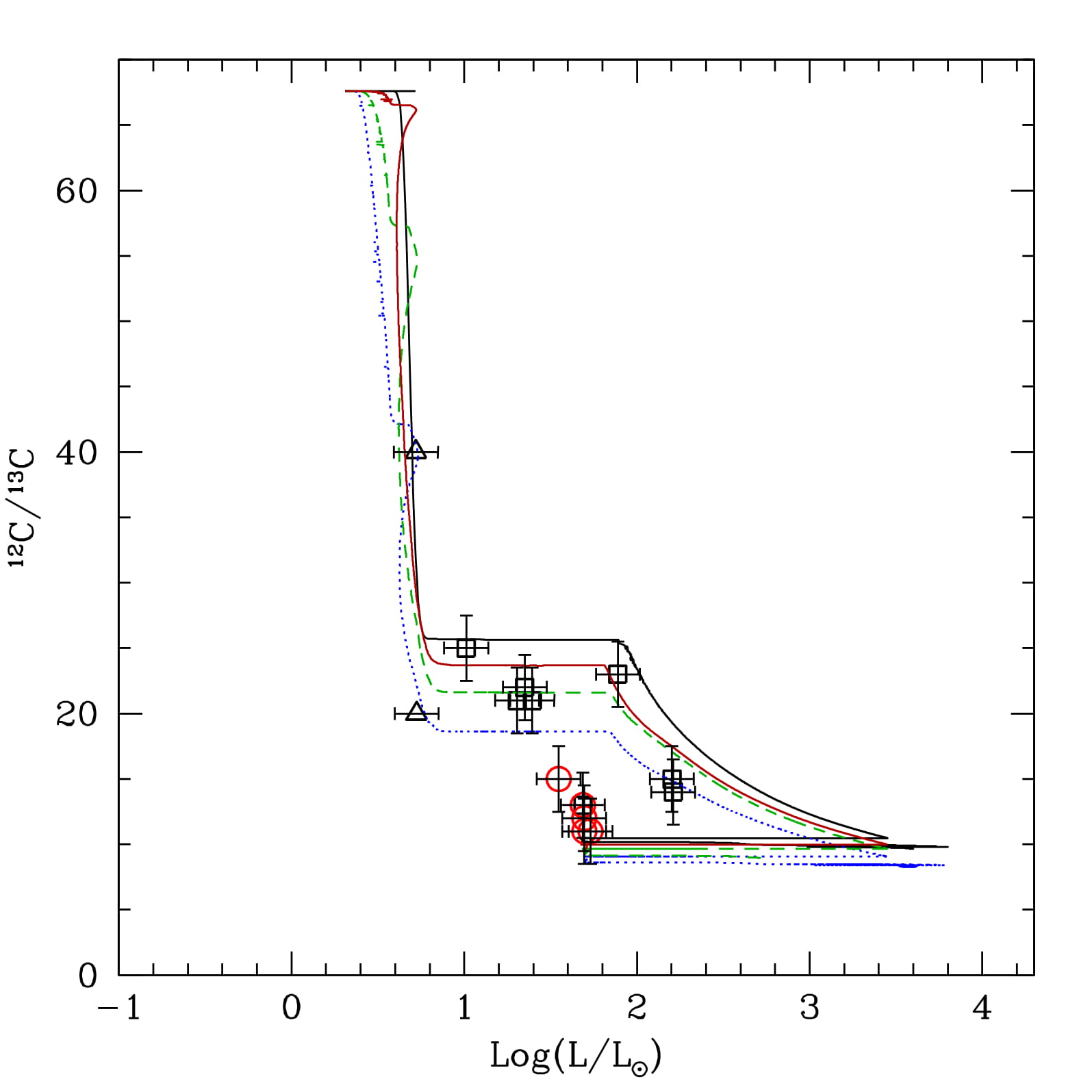Effects of thermohaline mixing and rotation-induced mixing
Context: Numerous spectroscopic observations have provided compelling evidences for a non-canonical
process that modifies the surface abundances of low- and intermediate-mass stars beyond the predictions
of standard stellar theory. With her grid of stellar models including different transport processes, I studied effects of these transport processes on stellar structure, evolution and nucleosynthesis.
Results: Consequences on the stellar surface properties and nucleosynthesis, and more particularly on the surface abundances of different chemical species (lithium, beryllium, carbon, nitrogen, helium and sodium), as well as on global seismic properties of low- and intermediate-mass stars, are discussed and presented in three articles published in Astronomy & Astrophysics.
The first two articles provide a detailed comparison between the theoretical predictions and surface abundances observed in field stars and in open clusters. This work confirms the importance of these two processes at different stages of stellar evolution, and the models successfully reproduce previously unexplained observations.
In the third article, the grids of stellar models computed following standard prescriptions, as well as including effects of both thermohaline mixing and rotation-induced mixing, are presented. The impact of thermohaline mixing and rotation-induced mixing on the global and asteroseismic stellar properties is described in details. This work opens interesting perspectives to interpret present and future data from CoRoT and Kepler missions for a large number of giant stars ; can revisit the description of the interior of stars in the later stages of their evolution, and to undertake statistical studies of stellar populations on the basis of their seismic properties.
These stellar evolution models have been largely used in the literature being crucial for different fields of astrophysics : stellar physics including spectroscopy and asteroseismology ; Galactic physics ; and to characterise host star in the planetary systems.
- “Thermohaline instability and rotation-induced mixing. III - Grid of stellar models and asymptotic
asteroseismic quantities from the pre-main sequence up to AGB for low- and intermediatemass
stars at various metallicities”
Lagarde N., et al., 2012b, 2012b, A&A 543, A108, citations count: 132 on 17/10//2018
- “Thermohaline instability and rotation-induced mixing in low and intermediate-mass stars. I -
Solar metallicity”
Charbonnel C. & Lagarde N., 2010, A&A, 522, A10. citations count: 164 on 17/10//2018
- “Beryllium abundances along the evolutionary sequence of the open cluster IC 4651 - New test
for hydrodynamical stellar models”
Smiljanic R., Pasquini P., Charbonnel C., and Lagarde N.,
2010, A&A, 510, A50. citations count: 29 on 17/10//2018
 Fig.1 - Evolution of the surface $^{12}$C/$^{13}$C value as a function of stellar luminosity for the 1.25 M$_\odot$ models including thermohaline instability and rotation-induced mixing (for initial rotation velocities of 50, 80, and 110 km.s^{-1} shown as solid red, dashed green, and dotted blue lines respectively). The non rotating case is also shown (black solid line). Observations along the evolutionary sequence of the open cluster M67 are from Gilroy & Brown (1991). The triangle is for a subgiant star for which only a lower value could be obtained, while black squares and red circles correspond respectively to RGB and clump stars
Fig.1 - Evolution of the surface $^{12}$C/$^{13}$C value as a function of stellar luminosity for the 1.25 M$_\odot$ models including thermohaline instability and rotation-induced mixing (for initial rotation velocities of 50, 80, and 110 km.s^{-1} shown as solid red, dashed green, and dotted blue lines respectively). The non rotating case is also shown (black solid line). Observations along the evolutionary sequence of the open cluster M67 are from Gilroy & Brown (1991). The triangle is for a subgiant star for which only a lower value could be obtained, while black squares and red circles correspond respectively to RGB and clump stars
Magnetic fields at the surface of giant stars
- “The magnetic strip(s) in the advanced phases of stellar evolution. Theoretical convective
turnover timescale and Rossby number for low- and intermediate-mass stars up to the AGB
at various metallicities”
Charbonnel, C, Decressin, T, Lagarde, N et al.
2017, A&A, 605, A102
- “The Magnetic Fields at the Surface of Active Single G-K Giants”
Aurière, M., Konstantinova-Antova, R., Charbonnel, C., Wade, G.A., Tsvetkova, S., Petit, P.,
Dintrans, B., Drake, N.A., Decresin, T., Lagarde N., et al.
2015, A&A, 572, L5
